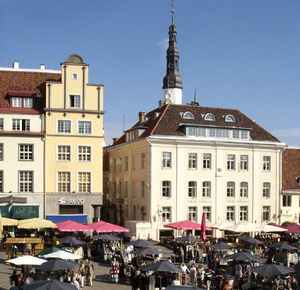- MENU
- HOME
- SEARCH
- WORLD
- MAIN
- AFRICA
- ASIA
- BALKANS
- EUROPE
- LATIN AMERICA
- MIDDLE EAST
- United Kingdom
- United States
- Argentina
- Australia
- Austria
- Benelux
- Brazil
- Canada
- China
- France
- Germany
- Greece
- Hungary
- India
- Indonesia
- Ireland
- Israel
- Italy
- Japan
- Korea
- Mexico
- New Zealand
- Pakistan
- Philippines
- Poland
- Russia
- South Africa
- Spain
- Taiwan
- Turkey
- USA
- BUSINESS
- WEALTH
- STOCKS
- TECH
- HEALTH
- LIFESTYLE
- ENTERTAINMENT
- SPORTS
- RSS
- iHaveNet.com: Travel
By Rick Steves

Tallinn's Town Hall Square
It's amazing what a stretch of water can do. The country of Estonia sits across the Baltic Sea from Sweden and Finland. Yet the struggles of the last couple of generations couldn't be more different on opposite sides of the sea. Traveling to this former Soviet republic spices up any visit to this region -- especially if you connect with the people and tune into their story about their struggle for freedom.
During World War II, Estonia lost its independence to Soviet expansion and sank into a 50-year communist twilight. In an attempt to "Russify" the country, the Soviets moved out Estonians, moved in Russians, and built massive-scale, cookie-cutter apartment blocks. During my visit here in the 1980s -- when labor was cheaper than light bulbs -- an old babushka would actually go through museums with me turning on and off lights as we went from room to room.
Those days are long gone.
Estonia's thriving capital, Tallinn, is like a Petri dish of capitalism. Just 50 miles from Helsinki and an overnight boat ride from Stockholm, the city is busy cleaning up the mess left by the communist experiment. New shops, restaurants, and hotels are bursting out of old buildings. Just a few years old, the striking
Creative businesses are flourishing all over the city. Once, while on a mid-morning coffee break, I stepped into a courtyard inhabited by booming little businesses. I wanted to sit at the courtyard's trendy little cafe with its wicker chairs rocking on the rough cobbles. The seat I was eyeing seemed empty, but it had a vest hanging on it. So I looked for another empty spot; it had a vest, too. I really, really needed a coffee and wanted a seat. Then I realized every chair had a different vest hanging on it. Estonian chic.
Despite modernization, Tallinn makes you feel that culturally, you've traveled far. The city's Nordic Lutheran culture and language connect it with its Scandinavian neighbors, but two centuries of Tsarist Russian rule and 50 years in the Soviet Union have added a distinctly Russian flavor. Among Nordic medieval cities, there's none nearly as well-preserved as this one. Its mostly intact city wall includes 26 watchtowers, each topped by a pointy red roof. Within its walled center, colorfully painted medieval houses share cobbled lanes with blocky, communist-style buildings.
While tourists see a peaceful scene today, Estonians still see reminders of dark times.
Locals joke that Hotel Viru -- a blocky white skyscraper -- was built from a new Soviet wonder material called "micro-concrete" (60 percent concrete, 40 percent microphones).
These days, the city is enlivened with Estonians enjoying their freedom. Baroque and choral music rings out from old Lutheran churches. The Town Hall Square -- where knights once showed off in chivalrous tournaments, and criminals were chained to pillories for public humiliation -- is now full of Scandinavians savoring cheap beer and children singing on the bandstand.
Just outside the city, the Song Festival Grounds host a huge national festival every five years, with 25,000 singers and 100,000 spectators. While it features big pop-music acts, too, it's most compelling for the role it played in Estonia's fight for independence in the late 1980s. Last summer, I visited here with a guide named Mati, who spent his time in the USSR military driving Soviet officers around the Crimea.
Mati explained to me that when Estonia was breaking away from the Soviet Union, more than 300,000 people -- a third of the country -- gathered to sing. Locals would put on folk costumes knitted by their grandmothers and travel here to sing in defiance of Soviet rule. This became known as the Singing Revolution. "We are so few in number we must emphasize that we exist," said Mati. "We had no weapons. All we could do was be together and sing. This was our power."
I was so inspired that I went back to my hotel, purchased the documentary "The Singing Revolution" from iTunes, and watched it right there. Any visitor to Estonia not tuned into this stirring bit of modern history misses a beautiful opportunity to be inspired by a valiant people's struggle.
© Rick Steves
AUTOS | HOBBIES | EDUCATION | FAMILY | FASHION | FOOD & RECIPES | HOME DECOR | RELATIONSHIPS | PARENTING | PETS | TRAVEL | WOMEN
Vacation Travel - Singing for Freedom in Estonia | Rick Steves' European Travels